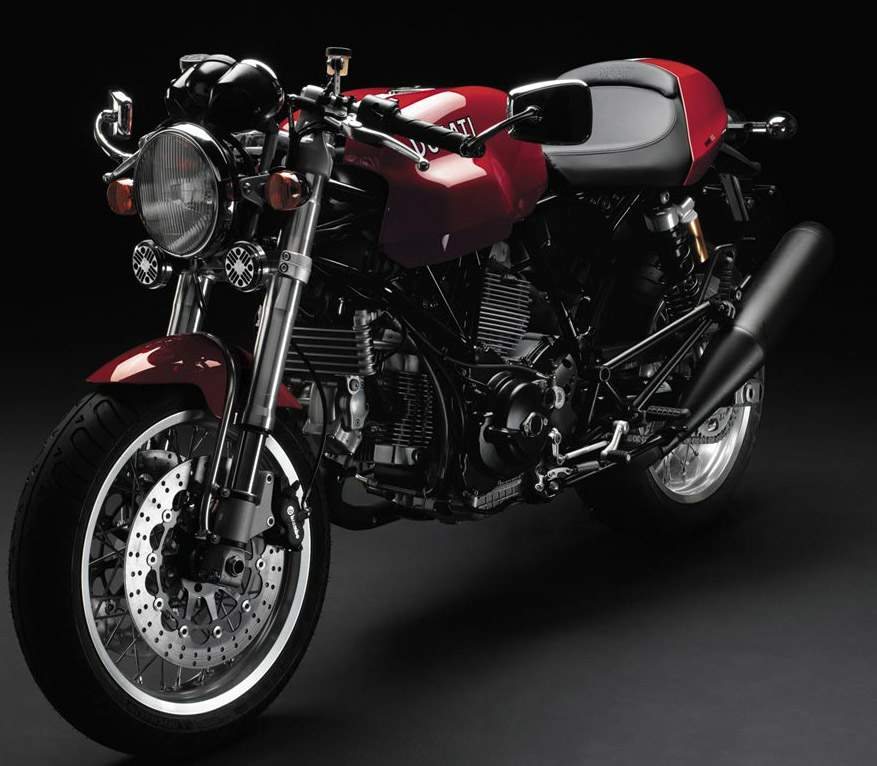
|
|
|
|
|
|
Classic Bikes
Custom Bikes
Individual
Racing Bikes AJP
AJS
Aprilia
Ariel
Avinton / Wakan
Bajaj
Benelli
Beta
Bimota
BMW
Brough Superior
BRP Cam-Am
BSA
Buell / EBR
Bultaco
Cagiva
Campagna
CCM
CF Moto
Combat Motors
Derbi
Deus
Ducati
Excelsior
GASGAS
Ghezzi Brian
Gilera
GIMA
Harley Davidson
Hero
Highland
Honda
Horex
Husaberg
Husqvarna
Hyosung
Indian
Jawa
Kawasaki
KTM
KYMCO
Laverda
Lazareth
Magni
Maico
Mash
Matchless
Mondial
Moto Guzzi
Moto Morini
MV Agusta
MZ / MuZ
NCR
Norton
NSU
Paton
Peugeot
Piaggio
Revival Cycles
Roland Sands
Royal Enfield
Sachs
Sherco
Sunbeam
Suzuki
SWM
SYM
Triumph
TVS
Ural
Velocette
Vespa
Victory
Vincent
VOR
Voxan
Vyrus
Walt Siegl
Walz
Wrenchmonkees
Wunderlich
XTR / Radical
Yamaha
Zero
Video
Technical
Complete Manufacturer List
|
Ducati 1000 Sport Classic Biposto

The Sport Classic family, which has met with great success since its appearance in 2003, replicates the styling of the motorcycles built in Ducati's workshops in the 1970s, characterised by a minimalist, sporting look, with an exposed frame and bodyparts in soft, rounded shapes. To emphasis the unique style of these bikes, Ducati has used top-level original components and finishes, featuring chrome and brightwork that provide the final touch, personalise the range and EVOke the lines of the bikes from which they're inspired. The whole SportClassic family mates retro style with modern technology and mounts the brilliant Desmo 1000 DS engine: delivering impressive torque, this air-cooled 90° "L" twin-cylinder is the ideal engine for these new sports models. The cylinders, with their traditional cooling fins and classic L-configuration, harken to the original design by Taglioni. The 1000 DS engine is equipped with the Desmo twin-valve system, fuel injection and an electronic engine control to guarantee power, reliability, thrilling performance and ease of use. As of 2007, the Sport 1000 will be available in two new versions: as well as the traditional single-seater, the Sport 1000 will be produced in an updated two-seater version for the new season, with a comfortable seat for both rider and pillion, complete with removable seat-cover so as to leave that perfect Café Racer style undiminished. Another two-seater version is the new Sport 1000 S, with a seductive new colour scheme of red frame and swingarm with black wheel rims and engine covers, and featuring a classic upper fairing with a round central headlamp, to give it a more aggressive look in keeping with 1970's tradition. As well as its two traditional colours red and grey, the GT 1000 will be presented in an original new two-tone livery of metallic black and cream, which recalls the original designs of this Ducati grand tourer.
PORT 1000 biposto In the 1970s, the most sports-oriented motorcyclists used to modify their road bikes according to what they saw on the track, including clip-ons handlebars, rear set footrests and aggressive colours. The aim was not just to make your bike look better but to enhance its performance too. And that's how the Café Racer style came into being. The Ducati Sport 1000 elegantly captures the audacious look of the motorcycles of that era. This year, as well as the single-seat version,
the SportClassic stable includes the new Sport 1000 biposto, a two-seater
which features a comfortable double seat, raised clip-ons to make the riding
position even more comfortable and retro style twin rear shocks. The two-seater version of the Sport 1000
embodies the same high quality and advanced technology as its single-seat
counterpart. Mounting high-performance Marzocchi 43 mm upside down forks up
front, twin Sachs shock rear suspension which are fully adjustable for spring
pre-load, and compression and rebound damping. The two rear shocks are fixed
at the bottom to an oversize 60 mm diameter tubular steel swingarm, which
features a simple, rational system (reminiscent of the one used on the 1970s
bikes) for adjusting chain tension. The special colour combinations put the distinctive finishing touches to this bike. The Sport 1000 two-seater is available in three different colours, featuring the characteristic longitudinal stripe down the middle of the fuel tank and tail section. The colours available for this model are: Burnt yellow with black stripe, Gloss black with white stripe and Ducati Red with white stripe, all three with a black frame. Colours Options -Model / Tank / Frame / Wheels Review
This piece of nouveau nostalgia is designed
to pull at the heartstrings of geezer sportbikers - those who
remember a time when air-cooling wasn't a hindrance to
performance and when dual shocks were the norm.
Also to blame for the lack of
anticipated nimbleness is the wheel/tire combination. When the
Sport 1K debuted last year, it was fitted with modern
recreations of the old Pirelli Phantoms, one of the hottest
tires of the 1980s and another tug of nostalgia. Our 2007 model
instead had a set of Michelins (Pilot Classics) that look
similar to a vintage set of Hi-Sports. These new versions
consist of modern compounds and construction which result in
good though not stellar grip levels. The super-fat front tire
seems wider than its 120mm rating and, together with a very
rounded profile, conspires to slow steering. Also, freeway rain
grooves can distract the leading Pilot from its path. But laid
into a corner, the Sport offers the soothing stability Ducatis
are known for. Source Motorcycle-USA
|
|
|
Any corrections or more information on these motorcycles will be kindly appreciated. |